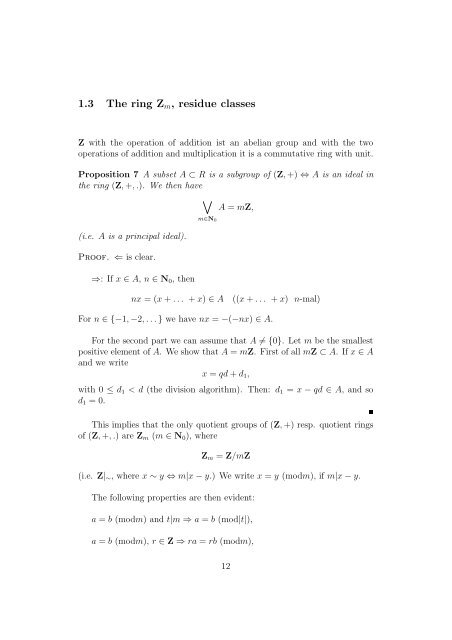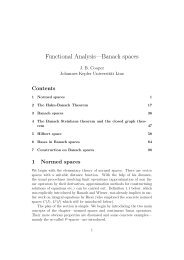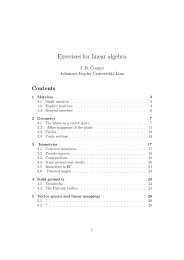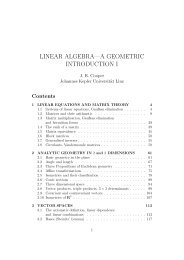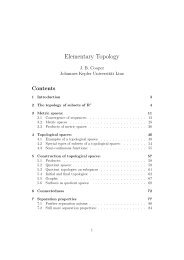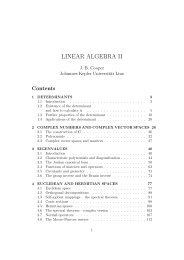Number theory, geometry and algebra - Dynamics-approx.jku.at
Number theory, geometry and algebra - Dynamics-approx.jku.at
Number theory, geometry and algebra - Dynamics-approx.jku.at
You also want an ePaper? Increase the reach of your titles
YUMPU automatically turns print PDFs into web optimized ePapers that Google loves.
1.3 The ring Z m , residue classes<br />
Z with the oper<strong>at</strong>ion of addition ist an abelian group <strong>and</strong> with the two<br />
oper<strong>at</strong>ions of addition <strong>and</strong> multiplic<strong>at</strong>ion it is a commut<strong>at</strong>ive ring with unit.<br />
Proposition 7 A subset A ⊂ R is a subgroup of (Z,+) ⇔ A is an ideal in<br />
the ring (Z,+,.). We then have<br />
∨<br />
m∈N 0<br />
A = mZ,<br />
(i.e. A is a principal ideal).<br />
Proof. ⇐ is clear.<br />
⇒: If x ∈ A, n ∈ N 0 , then<br />
nx = (x+... +x) ∈ A ((x+... +x) n-mal)<br />
For n ∈ {−1,−2,...} we have nx = −(−nx) ∈ A.<br />
For the second part we can assume th<strong>at</strong> A ≠ {0}. Let m be the smallest<br />
positive element of A. We show th<strong>at</strong> A = mZ. First of all mZ ⊂ A. If x ∈ A<br />
<strong>and</strong> we write<br />
x = qd+d 1 ,<br />
with 0 ≤ d 1 < d (the division algorithm). Then: d 1 = x − qd ∈ A, <strong>and</strong> so<br />
d 1 = 0.<br />
This implies th<strong>at</strong> the only quotient groups of (Z,+) resp. quotient rings<br />
of (Z,+,.) are Z m (m ∈ N 0 ), where<br />
Z m = Z/mZ<br />
(i.e. Z| ∼ , where x ∼ y ⇔ m|x−y.) We write x = y (modm), if m|x−y.<br />
The following properties are then evident:<br />
a = b (modm) <strong>and</strong> t|m ⇒ a = b (mod|t|),<br />
a = b (modm), r ∈ Z ⇒ ra = rb (modm),<br />
12


